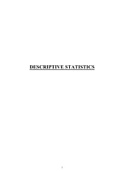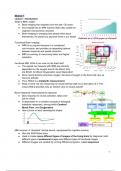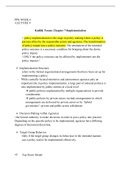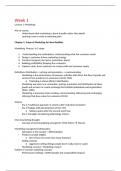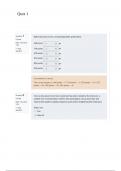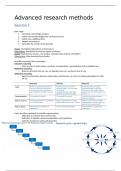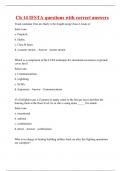WKS114
DESCRIPTIVE STATISTICS
1
,1.1 INTRODUCTION
The purpose of statistics is to gather information about data. Data sets are often so large that it is
impossible to make sense from it, and therefore it must be summarized.
Descriptive statistics comprises those methods concerned with collecting and describing a set of
data so as to yield meaningful information.
1.2 RAW DATA
Data that are not summarized or arranged in any way are called raw data.
The following table represents the lives of 20 similar car batteries recorded to the nearest tenth of a
year.
2.2 4.1 3.5 4.5 3.2
3.4 1.6 3.1 3.3 3.8
2.5 4.3 3.4 3.6 2.9
3.3 3.1 3.7 4.4 3.2
This is an example of numerical or quantitative raw data.
Suppose 20 students were asked to evaluate their lecturer. The results are given in the following
table where
E : Excellent
AA : Above average
A : Average
BA : Below average
P : Poor
E AA E AA
AA E A E
AA A E A
BA P BA E
A E AA BA
This is an example of categorical or qualitative raw data.
The data in the previous two tables are also examples of ungrouped data.
2
, 1.3 QUALITATIVE DATA
1.3.1 Organizing qualitative data:
Guidelines for constructing a frequency distribution table:
! The categories or classes of the variable are given in the first column. These categories
must be chosen so as to accommodate all the data and so that no item is placed under more
than one category.
! The score of each class is given in the second column.
! The frequencies ( f i ) of the classes are given in the third column. These frequencies
represent the frequency distribution of the variable. The sum of the frequencies is the
sample size and is denoted by n .
f fi
! The relative frequencies i are given in the fourth column. Note that
n
∑n
i
=1.
f
! The percentage i x100 for each class is given in the fifth column.
n
Example:
Consider the data on the evaluation of the lecturer and construct a frequency distribution table.
Category Score fi fi Percentage
n
Excellent (E) |||| || 7 0.35 35
Above average (AA) |||| 5 0.25 25
Average (A) |||| 4 0.2 20
Below average (BA) ||| 3 0.15 15
Poor (P) | 1 0.05 5
n = 20 1
Thus 35% of the students evaluated the lecturer as excellent.
1.3.2 Graphical presentation of qualitative data:
Bar chart:
A widely used form of graphic presentation of data is the bar chart. On the x-axis the
classes or categories are given and on the y-axis the frequencies.
How to draw a bar chart:
! Mark the categories on the x-axis;
! Mark the frequencies on the y-axis;
! Draw rectangles with heights equal to f;
! Leave spaces between rectangles.
3
DESCRIPTIVE STATISTICS
1
,1.1 INTRODUCTION
The purpose of statistics is to gather information about data. Data sets are often so large that it is
impossible to make sense from it, and therefore it must be summarized.
Descriptive statistics comprises those methods concerned with collecting and describing a set of
data so as to yield meaningful information.
1.2 RAW DATA
Data that are not summarized or arranged in any way are called raw data.
The following table represents the lives of 20 similar car batteries recorded to the nearest tenth of a
year.
2.2 4.1 3.5 4.5 3.2
3.4 1.6 3.1 3.3 3.8
2.5 4.3 3.4 3.6 2.9
3.3 3.1 3.7 4.4 3.2
This is an example of numerical or quantitative raw data.
Suppose 20 students were asked to evaluate their lecturer. The results are given in the following
table where
E : Excellent
AA : Above average
A : Average
BA : Below average
P : Poor
E AA E AA
AA E A E
AA A E A
BA P BA E
A E AA BA
This is an example of categorical or qualitative raw data.
The data in the previous two tables are also examples of ungrouped data.
2
, 1.3 QUALITATIVE DATA
1.3.1 Organizing qualitative data:
Guidelines for constructing a frequency distribution table:
! The categories or classes of the variable are given in the first column. These categories
must be chosen so as to accommodate all the data and so that no item is placed under more
than one category.
! The score of each class is given in the second column.
! The frequencies ( f i ) of the classes are given in the third column. These frequencies
represent the frequency distribution of the variable. The sum of the frequencies is the
sample size and is denoted by n .
f fi
! The relative frequencies i are given in the fourth column. Note that
n
∑n
i
=1.
f
! The percentage i x100 for each class is given in the fifth column.
n
Example:
Consider the data on the evaluation of the lecturer and construct a frequency distribution table.
Category Score fi fi Percentage
n
Excellent (E) |||| || 7 0.35 35
Above average (AA) |||| 5 0.25 25
Average (A) |||| 4 0.2 20
Below average (BA) ||| 3 0.15 15
Poor (P) | 1 0.05 5
n = 20 1
Thus 35% of the students evaluated the lecturer as excellent.
1.3.2 Graphical presentation of qualitative data:
Bar chart:
A widely used form of graphic presentation of data is the bar chart. On the x-axis the
classes or categories are given and on the y-axis the frequencies.
How to draw a bar chart:
! Mark the categories on the x-axis;
! Mark the frequencies on the y-axis;
! Draw rectangles with heights equal to f;
! Leave spaces between rectangles.
3

